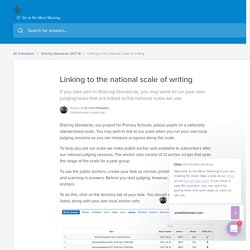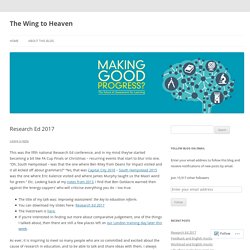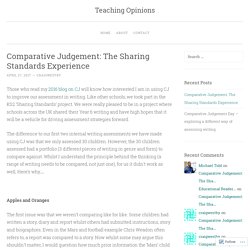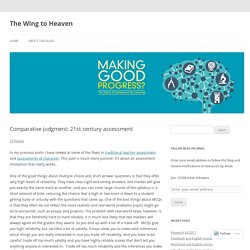

No More Marking – Institute for Effective Education. Linking to the national scale of writing. If you take part in Sharing Standards, you may want to run your own judging tasks that are linked to the national scale we use.

Written by Dr Chris Wheadon Updated over a week ago Sharing Standards, our project for Primary Schools, places pupils on a nationally standardised scale. You may wish to link to our scale when you run your own local judging sessions so you can measure progress along this scale. To help you use our scale we make public anchor sets available to subscribers after our national judging sessions. The anchor sets consist of 12 anchor scripts that span the range of the scale for a year group. To use the public anchors, create your task as normal, printing out bar coded sheets and scanning in answers. To do this, click on the Anchors tab of your task.
Click on the Public Anchors anchor set you would like to use. You will now see various details about the anchor set displayed. Giving specific feedback – The No More Marking Blog. A couple of weeks ago, Jamie McNamara wrote a great blog here about how using comparative judgement and whole-class feedback had helped teachers at his school to give pupils more specific, and therefore more useful, feedback.

Here’s a comparison of the feedback they give now with the feedback they gave before. I have noticed this too when I have been in schools and judging. When you’ve just read a series of scripts and they are fresh in your head, it is easier to give specific feedback of the type above. If all your colleagues have just read and judged the same set of scripts, it is also much easier to have a meaningful and productive discussion about how to improve the teaching of writing. With comparative judgement, you also get a link to each script, which makes it easy to share work on a projector, and to quickly review scripts on your own computer. Or you can pick out a really great sentence and share that, too. What does comparative judgement tell you that other forms of assessment don’t?
Research Ed 2017 – The Wing to Heaven. This was the fifth national Research Ed conference, and in my mind they’ve started becoming a bit like FA Cup Finals or Christmas – recurring events that start to blur into one.

“Oh, South Hampstead – was that the one where Ben Riley from Deans for Impact visited and it all kicked off about grammars?” “No, that was Capital City 2016 – South Hampstead 2015 was the one where Eric Kalenze visited and where James Murphy taught us the Maori word for green.” Etc. Looking back at my notes from 2013, I find that Ben Goldacre warned then against the ‘energy-zappers’ who will criticise everything you do – too true. The title of my talk was: Improving assessment: the key to education reform.You can download my slides here: Research Ed 2017The livestream is here.If you’re interested in finding out more about comparative judgement, one of the things I talked about, then there are still a few places left on our London training day later this week. Comparative Judgement: The Sharing Standards Experience – Teaching Opinions. Those who read my 2016 blog on CJ will know how interested I am in using CJ to improve our assessment in writing.

Like other schools, we took part in the KS2 ‘Sharing Standards’ project. We were really pleased to be in a project where schools across the UK shared their Year 6 writing and have high hopes that it will be a vehicle for driving assessment strategies forward. The difference to our first two internal writing assessments we have made using CJ was that we only assessed 30 children. However, the 30 children assessed had a portfolio (3 different pieces of writing in genre and form) to compare against. Whilst I understand the principle behind the thinking (a range of writing needs to be compared, not just one), for us it didn’t work as well.
Apples and Oranges The first issue was that we weren’t comparing like for like. Rather than: We were doing: Staff had to scroll back and forth to try and make comparisons from the sets of work. Recommendations Final thought. Comparative judgment: 21st century assessment. In my previous posts I have looked at some of the flaws in traditional teacher assessment and assessments of character.

This post is much more positive: it’s about an assessment innovation that really works. One of the good things about multiple-choice and short answer questions is that they offer very high levels of reliability. They have clear right and wrong answers; one marker will give you exactly the same mark as another; and you can cover large chunks of the syllabus in a short amount of time, reducing the chance that a high or low score is down to a student getting lucky or unlucky with the questions that came up.
One of the bad things about MCQs is that they often do not reflect the more realistic and real-world problems pupils might go on to encounter, such as essays and projects. The problem with real-world tasks, however, is that they are fiendishly hard to mark reliably: it is much less likely that two markers will always agree on the grades they award.